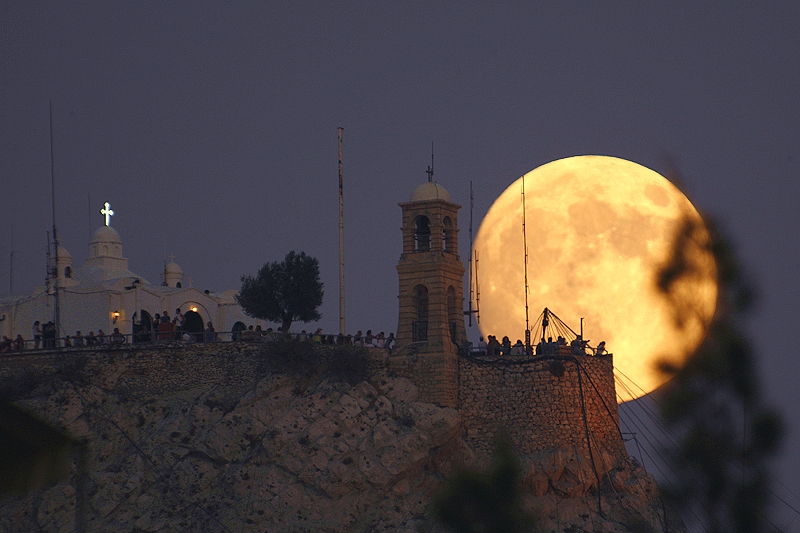
Our closest celestial neighbour has kept us company for at least four billion years and has entertained our imagination in a variety of
ways. It certainly has been involved in our maturation as a species with man's first step on a body beyond our planet during the latter
part of the twentienth century and will, inevitably, be our first stop prior to any sort of manned travel to a further celestial body
such as Mars. The moon has been a great source of education about our own planet's evolutionary history; it has entertained many
inquisitive minds from earlier cultures and generations about the universe in general and man's role in particular; it has enriched the
minds of young children taking their first look through a telescope and continues to impact our lives in ways we may or may not readily
recognize including tidal forces and various natural rhythms and cycles.
Note: The image below is a follow-up to other similar efforts involving the rising (full) moon near dusk and
against well-known landmarks in Greece including archaeological grounds (see
here). Such an exercise requires careful planning and execution
so that the azimuth and altitude of the rising moon match precisely with the foreground landmark of interest. Also important is the time during
late afternoon that such an attempt is executed, for one requires balanced lighting between the foreground landmark and the bright rising
(full) moon. Once all of these factors are available simultaneously with respect to lighting balance (full moon and landmark foreground) as
well as azimuth and altitude, a result such as the one below involving the Church of Saint George atop Lycabettus Hill in Athens is realized.
Lycabettus Hill ("Hill of the Wolves") lying at the center of Athens is approximately 280 meters high and is the highest of the seven hills
which characterize the Greek capital. At the top of the hill, one will find the Church of Saint George and which is a very popular tourist
attraction during summers for viewing the setting sun in the distance and as was the case below when the image was taken, for the setting sun
had just set a few minutes earlier and most of the tourists visible in the image had set their sights on the rising moon in the opposite
direction. The image was taken from a distance of 1380 meters and across the National Archaeological Museum of Athens so as to purposely
match as closely as possible the apparent size (diameter) of the Church of Saint George and the rising 13-day old moon.
Note: For additional photos of the rising moon from the same session as well as photos of the sun and/or full moon
against other well-known Greek archaeological grounds and sites, please click
here.
|
Body: Moon Mass: 0.0123 x Earth Mean Eq Diameter: 0.2719 x Earth Distance: 405,846 km Sidereal Rev: 27d 07h 43m 11s Age: 13d 14h 24m Phase: 98.5° Diameter: 29.52' Magnitude: -12.4 Rukl: N/A |
 |
Date: Aug 04, 2009 20:38:10 UT+3 Location: Athens, Greece (37.9889° N, 23.7306° E) Equipment: Takahashi FSQ 106/f5 AP 2x Conv Barlow Canon EOS 5D Mark I Baader UV/IR-Cut Filter Exposure: 1 x 1/10 sec ISO 100 RAW Image Format 4368x2912 image size Manual Mode Servo Mode Software: Digital Photo Pro V1.6.1.0 Photoshop CS2 Processing: Resampling JPG Compression |